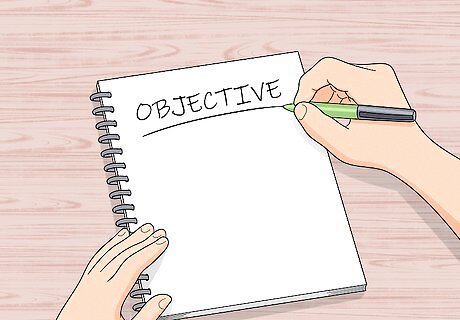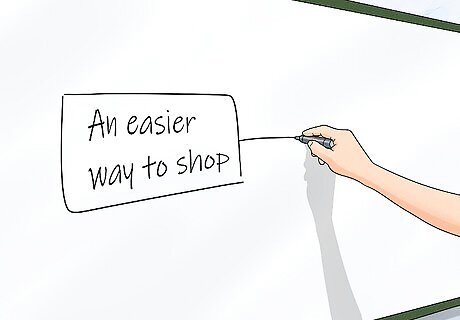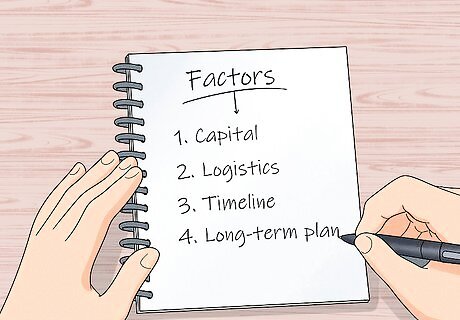
views
Setting Up Your Brainstorming Session

Define the objective of your brainstorming session. You need to know what you hope to gain from brainstorming. Whether you hope to clarify a business model, come up with a business idea or product, or find a solution to a customer need, you have to be absolutely clear about the purpose of your discussions. What do you want to have in the end? A completed business plan? A product design? Write this objective down and place it prominently in your brainstorming space to keep you and your team on track.

Come up with a starting point. Regardless of whether or not you have an actual business idea yet, you need a starting point from which your other brainstorming ideas can flow. Small business ideas typically start as something the founder notices, like some kind of unmet need in his or her community or an idea that they have to improve a process. These can be sudden insights or the result of noticing small things through years of work in a certain industry or profession. Whatever idea you have that has caused you to bring people together and think up a small business, define it, and then move forward from there. It is also important to clearly and succinctly define the starting point or the impetus for the brainstorming session so that everyone is focused on the same input and outcome. The most successful companies started with a combination of a recognized need in the market and a new technology. For example, Google combined people's need to find things easily online with their proprietary search technology. A good starting place could be either one or both, of these two parts.

Decide what you want from your business idea. Your starting point doesn't necessarily have to be a solid business or product idea. Instead, it can be a goal, like making money, creating a unique product, or gaining market share. This is more difficult to start with, as you have no guidance on deciding what exactly your future business will do or make. However, this also opens up limitless possibilities. And even if you do have a solid idea, determining what you want from your business can help you with long-term planning.

Brainstorm with a group of people. Do not invite people who will think the same way as you. Successful brainstorming comes from different opinions and perspectives. Allow these people to share their own viewpoints, problems, and experiences. For example, you could brainstorm with small business experts or set up a meeting with a mentor or a business leader who you respect and admire. Pitch your ideas to the expert and welcome any feedback. Be willing to hear positive comments and negative criticism. Express your gratitude to everyone who helped. Few people brainstorm on their own, so be sure to say thanks to the team who brainstormed with you. Time is a valuable resource, and people will appreciate your acknowledgment of their help and insight. EXPERT TIP Alena Le Blanc Alena Le Blanc Personal Stylist Alena Le Blanc is the Personal Stylist and the Founder of Le Blanc Label. Based in San Francisco, California, Le Blanc Label is the leading personal stylist brand for sustainable style transformations. Alena and her team specialize in seasonal wardrobe refreshes, closet edits, styling for special events, travel, photoshoots, and general personal needs. Alena has been featured in podcasts including EMPOWERED BY WMN, I Am Fearless, and Mind Power Meets Mystic. Alena received her BFA in Fashion and Apparel Design from the Academy of Art University. Alena Le Blanc Alena Le Blanc Personal Stylist Find a mentor to offer you guidance. Reach out to an expert who can offer specific business advice tailored to your industry. Consider joining online communities for entrepreneurs to build a network of like-minded individuals. You'll gain valuable knowledge for the early stages of building your business.

Set up your brainstorming location. Your brainstorming location is almost as important as the team that you select. Make sure to choose a relatively quiet location, free of outside distractions or noise. Then, remove all electronic devices from the room, except for computers used for research. Provides team members with individual notepads to write down ideas. Have a whiteboard, chalkboard, or large pad in a central location to keep track of everyone's ideas. Consider playing music to enhance creative thought. Try using classical music without words. Provide drinks, like water or coffee, to keep your team hydrated and focused. It may help your team to get out of the area where you usually meet, like going on a retreat or simply going outside to a park. Changing your surroundings can help you see new perspectives and change your thought patterns.
Developing Ideas

Research relevant subject matter. Read articles, search the Internet and watch videos about subjects that are relevant to the business ideas you are brainstorming. The more information you have, the better decisions you can make. You should also look at any past attempts you or anyone else has made to solve the problem you are addressing or fix the product you are focused on. What did they do right? Where did their attempt go wrong? Bringing this type of context to your discussions can help shape your own ideas. Learn about the industry you are hoping to get into. Look at its organization, major players, and relevant government regulations. You can also reach out to business connections of yours who are involved in this industry to get their thoughts on certain aspects of the market.

Think independently. Have your group members brainstorm the idea individually and then collect their notes in a Google doc or dropbox folder. Then, have everyone review everyone else's ideas individually and come up with new thoughts. Finally, come together as a group and share these new ideas. That way, you start off with a broader base of ideas.

Question market assumptions. Many successful startups are disruptive in that they offer something completely new to the market that eventually changes how that market functions. Think about Uber or Airbnb, which have perfected new solutions to common problems. These were solutions that no one was sure would work in practice and that stood against the current status quo of their respective markets. To start, try breaking down a consumer need or imperfect product into its essence. What service is being provided? Ignore current solutions to think of news ways that the problem can be solved. Address current assumptions about that product or service directly by writing them down. Then, think of ways around those assumptions or ways to replace them. Some successful new companies simply make a change to the prevailing business model of their industries, not necessarily changing the product offerings or need to be addressed. Don't focus so much on your offering that you forget the potential benefits of a better business model.

Honor all suggestions and ideas. Brainstorming cannot work if limitations are put on the creative process. Treat every idea by each member of the brainstorming idea the same way, developing it and asking questions until it is either deemed impractical or it graduates to the "good idea" list. Agree to consider all ideas, regardless of how impossible they seem. In fact, coming up with terrible ideas can be beneficial to your creative process. Try coming up with the worst ideas you can think of (illegal, impractical, or expensive ideas). Then, try to change those ideas to make them better ideas. This process can help you think of your problem in new ways.

Ask questions. Brainstorming requires that you ask specific and general questions about every aspect of each idea. Try to ask questions that force your team to consider alternatives, rethink assumptions, or continue with their current train of thought. Leave your questions open-ended and allow your team members ample time to think and respond.

Document your brainstorming session. Assign a group member to be the secretary or scribe for the meeting. Have them record everything discussed, ideas that you choose to move forward with, and your progress or stopping point. This will allow you to pick up where you left off when you have your next session.

Repeat your brainstorming session. It's not likely that you will come up with your million-dollar idea on your first try. Be persistent and meet regularly with your brainstorming group or with different groups to come up with new ways of thinking. Your idea may come to you in a later session or at a completely unexpected time. Just make sure to save your notes from previous sessions so that you don't lose any progress. Be sure to evaluate your process. When you finish your brainstorming, take some time to note what worked well and what did not work for you in coming up with small business ideas. This will help you in future brainstorming and strategy sessions.
Focusing Your Idea

Assess your ideas. The best ideas are useless if you can't see a way to develop them into a fully-functioning business. When you've come up with several of them through brainstorming, assess your ideas using the following criteria: Are you the right person to build on this idea? Do you have the experience or technical know-how required to solve this problem better than your competitors? Will customers want this product or service? A product can be useful in theory, but not enough to make customers actually pay for it. Does this idea solve a problem that the customer has? Does it do so effectively and efficiently? Is the market ready? Consider your potential competitors and the barriers to entry that they may present. Also, think about whether there are enough prospective customers to keep your business afloat. Consider your operations. Can you make a business structure to build or provide this product or service? More importantly, can you gather the capital required to develop and build it?

Define all the factors and details that need to be considered. Be prepared for the challenges and opportunities that come with the small business ideas you are brainstorming. For example, think about the following: The money you will need to start. Brainstorm how much capital will be required to start your small business. Talk through the best ways to raise that money, whether through loans or investors. The logistical factors that are involved. List the operational aspects of your small business that will need attention, including staff, inventory, physical space for the business and marketing costs. Your timeline. Figure out how much time it will take to start the small business and turn it into a success. Your long-term plan. Figure out what needs to be done first, then the next steps after that.

Choose the best idea. The best idea can be chosen according to a few important criteria. First, assess the cost. Can you come up with the money needed to pursue this idea? Then, consider your business's ability to create this product or service. Do you have the expertise, capability, and capacity needed? Finally, look for a competitive advantage in your ideas. Can you create this idea faster, better, or more cheaply than your competitors? Only once an idea passes these criteria should you move forward with it.

Create a business plan. Once you have completed your brainstorming and you have a vision for your small business, write it down. This will be an abbreviated business plan, which is simply a framework for your business with as much information as you currently have, rather than a full business plan. Start with a one-sentence description of your idea. What do you do and what will the effect of this product or service be? Then, write a short description of this product or service, using the information you have thus far. Write out what you know about your business organization, such as your management structure, distribution model, and pricing plan. Determine what it might cost to develop and produce your product or prepare to provide your service. Include all potential start-up costs. Then, include what you know about the market, from competitors and market share to trends and potential customer base.

Get started. The only way to know if your business plan will work is to try it. Start asking around to your colleagues and connections to form a team to make your idea happen. Begin networking with people to the industry you are trying to enter. Come up with ways to finance your business. Most importantly, continually refine your idea or product until it is good enough to take to market.




















Comments
0 comment